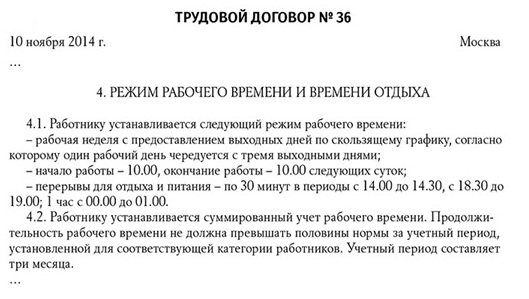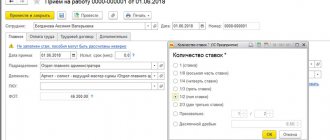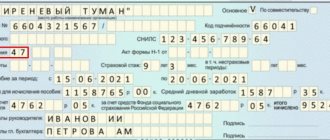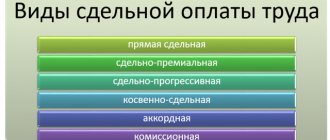What it is?
Working hours are a routine established by law that specifies the length of the working week and daily work (shift), start and end times of work, time of breaks in work, alternation of working and non-working days.
A full definition of the working time regime is contained in Article 100 of the Labor Code of the Russian Federation.
Lawyers also include:
- setting up equipment, preparing tools and tools, arranging the workspace and putting things in order;
- forced downtime, associated not with the will of the worker, but with technical and technological (failure of equipment), organizational (supplier did not deliver equipment, construction materials, goods on time), economic (financial troubles of the employer) and other reasons;
- snack, coffee break, exercise;
- specific breaks for special purposes (for the purpose of heating or cooling);
- feeding the baby.
Working hours do not include a change of work clothes, and travel time to work does not count
In general, working time is the time period allocated for the production of actions. However, the physiological properties of a person are such that people are physically unable to continuously fulfill their work duty . Therefore, at the legislative level, not only the system of activity, but also relaxation is designed.
Here you can learn more about the legal lunch break.
If the work regime at the enterprise changes, a corresponding order is issued to comply with working hours (clickable):
Difference from hours actually worked
In addition to the two interpretations of working hours mentioned above, there is the concept of actually worked time . These definitions are not equivalent. If the duration of working time is understood as its regulated period, for example, from 8:00 to 17:00, then the actual time worked will be less. Working hours include a lunch break, but that's not all. Employees can also take breaks during the day for short rest, smoke breaks, and so on. In other words, the actual time worked is always less than the length of the working day.
Structure
A worker’s working time consists of two equally important components: work time and break time .
Working hours
Forms the basis of labor relations. Has the following structure:
- Preparatory time. This stage is the shortest: the worker prepares the workplace before work (handles tools, turns on and configures equipment, for example), cleans and submits documentation at the end of the day. The time calculation for this period does not depend on the total amount of work.
- Operational. Divided into main and auxiliary: the main time is spent on the implementation of work duties and “manipulations”; auxiliary is used for secondary actions (for example, movement or sanitary cleaning).
- Maintenance time. Allocated to maintain the condition of the workplace or mechanism that ensures labor productivity.
Break time
There are two types:
- regulated (time for rest, for personal needs);
- unregulated (dictated by violation of labor discipline (personal conversations, engagement in extraneous matters not related to production), or production procedures (switching off water, electricity, lack of required materials, discrepancy in air temperature, atmospheric pressure, etc.).
Working hours necessarily include various types of breaks . Their absence means a gross violation of workers' rights!
To avoid troubles, when drawing up an employment contract, it is necessary to take into account and spell out all the nuances associated with the working hours.
Payment for night work
Each hour of work at night (from 22.00 to 6.00) is paid at an increased rate compared to work in normal conditions, but not lower than the amounts established by labor legislation (Part 1 of Article 154 of the Labor Code of the Russian Federation) regardless of the remuneration system and type working time recording.
The minimum increase in wages for night work is established by law and is 20 percent of the hourly tariff rate (salary calculated per hour of work) for each hour of night work.
To reflect the hours worked at night in the time sheet, use the letter code “H” or the numeric “02” indicating the number of hours worked at night.
Kinds
Working hours are of the following types : normalized type, irregular, flexible, shiftable, divided, rotational.
Each employee is given an individual work schedule, depending on his specialty and responsibilities.
A blank work schedule form can be downloaded for free here.
Standardized type
The key and most common due to the convenience of tariffing: 40 hours a week is the standard that every working person must meet . The organization sets a schedule consisting of working days and days off, either autonomously or in agreement with the union.
Pros:
- suitable for almost all types of production and non-production work;
- simplicity of tariffing and calculation of the employee’s personal time.
Irregular
Specific type of work: workers are occasionally urgently called to work during non-working hours at the request of the employer or in exceptional cases (Article 101 of the Labor Code of the Russian Federation).
- Pros: possibility of getting additional vacation.
- Disadvantages: the worker cannot refuse overtime work, otherwise he will face administrative punishment.
Flexible schedule
Working in this mode presupposes complete independence of the subordinate in relation to setting the beginning, end or total duration of the working day (shift) (Article 102 of the Labor Code of the Russian Federation). In this case, the worker is required to work a certain number of hours.
This schedule was initially used exclusively for women with small children, whose daily routine did not allow the mother to work as usual.
Pros:
- the permissibility of organizing the working day depending on the desires and capabilities of the worker;
- Flexible work is popular among students, retirees and mothers with small children.
Replaceable type
If the production process is delayed and exceeds the permissible norm of eight hours, if there is no other way to increase the productivity of equipment, the volume of products produced or the number of services provided, then in such cases, shift work is introduced (Article 102 of the Labor Code of the Russian Federation).
Processing in excess of the permissible norm may occur. You must carefully monitor the number of hours worked !
Pros: a decent amount of time off, increased due to long working hours.
Dividing the working day into parts
The schedule is provided for exceptional cases: for specialties and professions with a special load (doctors, educators, dispatchers, etc.) (Article 105 of the Labor Code of the Russian Federation). Then the working day is divided into parts, that is, several teams can change during the day .
There are violations when providing days off. Be careful when scheduling!
Watch
Working hours for people working far from their place of residence. The shift of such workers usually lasts from two to four weeks, and the rest is about a month .
Pros: high earnings for workers, since they often do not have to spend money on accommodation and travel to work.
Shift working hours
It is a form of performance of labor activity by an employee without the possibility of daily return to his place of residence. This regime is usually used by employers during the construction or reconstruction of facilities in order to reduce the time frame for project implementation. Shift work involves providing employees with conditions for normal living, most often these are special mobile buildings and structures created by the employer, equipped with everything necessary. The duration of the shift is determined by labor legislation and is no more than 1 month (if the shift period is increased to 3 months, Article 299 of the Labor Code of the Russian Federation, the employee is paid additionally). The duration of a work shift during a shift should be no more than 12 hours. For the calculation, the summarized accounting of working hours for a month, quarter or 1 year is used. This accounting period includes total working time, time spent traveling to the collection point, place of work and back, rest time, which coincides with the calendar period. The shift work schedule is communicated to employees no later than 2 months in advance. This regime provides for a number of restrictions (Article 298 of the Labor Code of the Russian Federation), according to which the following cannot be hired to work on a rotational basis:
- workers under 18 years of age;
- pregnant women;
- women who are dependent on young children under 3 years of age;
- employees who have medical contraindications.
Regulation
All required information on the regulation of working time is contained in Part III, sections IV (“Working time”) and V (“Rest time”) of the Labor Code of the Russian Federation:
- Article 91 describes how long the working week should last and its structure;
- by referring to Article 92, the worker will find out cases of reduction of the working day;
- the work shift, its composition and duration are described in Article 94;
- everything about pre-holiday and pre-weekend days is contained in Article 95;
- a whole set of articles coordinates information about breaks: how much time is required for rest and food (Article 108); heating period (Article 109); how often can you leave to feed the child (Article 258).
Employment is an important process. Its occurrence is noted in a large number of different documentation:
- The central document that regulates this issue is the Labor Code of the Russian Federation of December 30, 2001. It contains provisions and norms common to all workers.
- Exceptional issues (relating, in particular, to shift patterns) are discussed not only with the worker, but also with the trade union , in order to take into account the point of view of the entire workforce.
- personal schedule is prescribed in an individual employment contract: the information is approved in the form of a table.
- Other regulatory acts of the enterprise.
When applying for a job, carefully read all the documents provided!
An example of how the working hours are reflected in an employment contract:

Payment for holidays or weekends with summarized accounting
If an employee’s working day falls on a non-working holiday, then the code “РВ” is entered in the working time sheet, despite the fact that this working day is included in the employee’s schedule. In this case, the employee is also subject to the provisions of Art. 153 of the Labor Code of the Russian Federation on increased payment for work.
According to the Recommendations of Rostrud dated June 2, 2014, when introducing summarized working time recording, work on holidays must be included in the monthly working time standard.
If an employee was involved in work on his day off or on a non-working holiday in excess of the monthly norm established for him or in excess of the norm in accordance with the accounting period, then such work will be subject to payment in accordance with Art. 153 Labor Code of the Russian Federation. The employee can also take another day of rest.
If within the accounting period the employer has already paid for non-working holidays, then at the end of the accounting period he does not need to pay for them as overtime. The Decision of the Supreme Court of the Russian Federation dated November 30, 2005 N GKPI05-1341 provides an explanation for this case: “Since the legal nature of overtime work and work on weekends and non-working holidays is the same, payment in an increased amount is simultaneously based on Art. 152 of the Labor Code of the Russian Federation, and Art. 153 of the Labor Code of the Russian Federation will be unreasonable and excessive.”
Reference
A certificate of working hours may be needed under certain circumstances:
- First case. Such a certificate is required from a woman applying for a special work schedule due to the presence of a small child. Then the worker’s husband must provide a certificate from his place of service to confirm the need for a special regime.
- Second case. If you are fired or laid off, you can apply to the employment service for unemployment benefits. Under these circumstances, it is necessary to provide a certificate of working hours in order to calculate the average wage of the worker.
Example of a certificate about working hours:
At the moment, the labor sphere is characterized by a large abundance of work schedules. When choosing one mode or another, be guided by the specifics of your profession, family circumstances and characteristics of physical and mental health .
The well-being of not only the employee, who makes a choice in favor of one or another schedule, but also the employer, whose well-being is directly determined by the labor productivity of his subordinates, depends on the working mode chosen by the worker .
Watch the video about working hours:
Split working hours
This regime is regulated by Art. 105 of the Labor Code of the Russian Federation, and, as a rule, is applicable when performing work with unequal intensity throughout the entire work shift. For example, a fragmented operating mode is used by organizations providing transport services to the population, communication services and trade. The division of working time is carried out by the employer in accordance with the internal rules of the organization, drawn up taking into account the opinion of the trade union body. Russian labor legislation does not stipulate how many parts a working day can be divided into, but, as practice shows, a shift is divided into 2 or more parts, and the unpaid break between them can be no more than 2 hours.










